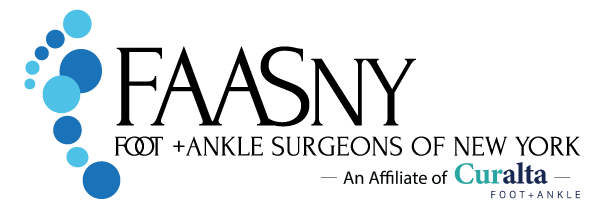Arthritis – Podiatrist on Long Island
What is it?
Arthritis is inflammation of one or more of your joints. It can cause pain and stiffness in any joint in the body, and is common in the small joints of the foot and ankle. Arthritis can be found any of the several joints. Most common form of foot and ankle arthritis is osteoarthritis where the cartilage in a joint gradually wears away. As the cartilage is damaged, the protective space between the bones decreases and leads to “bone rubbing on bone” and pain, swelling and difficulty walking that worsens over time.
Causes
An injury may lead to osteoarthritis, although it may take months or years after the injury for the condition to develop. For example, osteoarthritis in the big toe is often caused by kicking or jamming the toe, or by dropping something on the toe. Osteoarthritis in the midfoot is often caused by dropping something on it, or by a sprain or fracture. In the ankle, osteoarthritis is usually caused by a fracture and occasionally by a severe sprain.
Sometimes osteoarthritis develops as a result of abnormal foot mechanics such as flat feet or high arches. A flat foot causes less stability, resulting in excessive strain on the joints, which can cause arthritis. On the other hand, a high arch is rigid and lacks mobility, causing a jamming of joints that creates an increased risk of arthritis.
Diagnosis
Often, arthritis can be diagnosed from a through history and physical exam. X-rays and laboratory tests often can confirm the type and extent of the arthritis. Other tests such as a computed tomography (CT) scan or magnetic resonance imaging (MRI) may be used to evaluate the condition. For foot and ankle arthritis, weight-bearing radiographs–x-rays taken while standing– are important in diagnosing the severity of arthritis and any joint deformity associated with it.
Treatments
There is no cure for arthritis but there are a number of treatments that may help relieve the pain and disability it causes. Nonsurgical treatment includes assistive devices such as AFO braces and foot orthoses, ant-inflammatory medications and injections, as well as physical therapy.
Surgical treatment depends on the specific joint involved and the extend of the condition. Arthroscopic procedures to remove loose cartilage, inflamed synovial tissue, and bone spurs may be helpful in the early stages of the disease. Advanced arthritis or that involves a deformity often requires arthrodesis or fusion of the involved joint(s). The goal of the procedure is to reduce pain by eliminating motion in the arthritic joint. Joint replacement surgery may be of help in some instances, but has a limited role in foot and ankle arthritic conditions.
